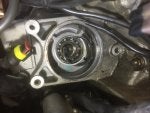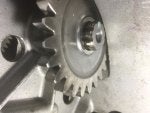A few guys have asked me for instructions on replacing the Z25 gear and shaft, so I thought that it might be worth posting these for all and sundry.
NOTE :- This is how I went about it and it worked for me but you choose to follow these instructions at your own risk
Right here we go :-
Undo the 3 bolts and remove the clutch actuator as this needs to be out of the way to remove the alternator. Use some cable ties to pull the coolant pipes temporarily out of the way to-wards the front of the bike.
Remove the alternator and you will see the alternator drive flange and cush drive rubbers. These rubbers may be worn and should be inspected/changed as they have been known to disintegrate.
The O-ring fitted to the groove in the alternator can stretch with age and may need to be shortened and re-joined with superglue or replaced to prevent it getting damaged when refitting the alternator into it's recess, resulting in an oil leek.
You will see the Z25 bolt in the centre of the alternator drive flange. There should be a tab washer fitted to prevent the bolt from un-doing itself; this is no longer the preferred method as a Bellville washer is now used. Bend the tab washer away from the bolt head.......bit fiddly if I remember!
The clutch basket needs to be fitted to prevent the shaft from turning when you try to undo the old z25 bolt. Put the bike in top gear and apply the rear brake to undo the Z25 shaft bolt, or hold the clutch with a clutch holding tool to prevent it from turning.
Remove the z25 bolt, discard the tab washer and remove the alternator drive flange from the end of the Z25 shaft. Remove clutch. Use a rod to push out the z25 shaft from the alternator side and leave the rod in place as this will hold the internal crankcase gear in situ and prevent it from dropping out of position (you do not want this to happen)
Fit new Z25 gear and shaft ensure etched triangles are aligned (if the upgraded parts have them) and tap the shaft to drive the rod you left in place earlier through to-wards the alternator side. Refit the drive flange and then the new washer and bolt with the correct loctite as you don't want this to come off again in a hurry. Check the nut on the end of the alternator spindle to make sure this is not loose then fit the cush rubbers and alternator but be careful you don’t snag the alternator 'o' ring. NOTE:- A small spot of superglue can be used to temporarily hold the rubbers in place when you refit the alternator.
Refit clutch etc.
The relevant torque settings for a 900 Tornado and the Loctite codes are noted below along with the spec of the HT bolt:-
- The clutch main nut torque is 80 NM (NOTE:- torque to only 50 NM for a dry clutch) with loctite 648 applied
- The clutch cover torque is 10 NM no loctite applied
- The Z25 bolt torque is 50 NM with loctite 648 applied
- The alternator torque is 27 NM with loctite 243 applied
- The clutch actuator torque is 10 NM with loctite 243 applied
- Z25 bolt - M10x1.25 (metric fine thread) x 25mm long 8.8 specification high tensile bolt
There are a couple of pics on this post which may help.
NOTE :- This is how I went about it and it worked for me but you choose to follow these instructions at your own risk
Right here we go :-
Undo the 3 bolts and remove the clutch actuator as this needs to be out of the way to remove the alternator. Use some cable ties to pull the coolant pipes temporarily out of the way to-wards the front of the bike.
Remove the alternator and you will see the alternator drive flange and cush drive rubbers. These rubbers may be worn and should be inspected/changed as they have been known to disintegrate.
The O-ring fitted to the groove in the alternator can stretch with age and may need to be shortened and re-joined with superglue or replaced to prevent it getting damaged when refitting the alternator into it's recess, resulting in an oil leek.
You will see the Z25 bolt in the centre of the alternator drive flange. There should be a tab washer fitted to prevent the bolt from un-doing itself; this is no longer the preferred method as a Bellville washer is now used. Bend the tab washer away from the bolt head.......bit fiddly if I remember!
The clutch basket needs to be fitted to prevent the shaft from turning when you try to undo the old z25 bolt. Put the bike in top gear and apply the rear brake to undo the Z25 shaft bolt, or hold the clutch with a clutch holding tool to prevent it from turning.
Remove the z25 bolt, discard the tab washer and remove the alternator drive flange from the end of the Z25 shaft. Remove clutch. Use a rod to push out the z25 shaft from the alternator side and leave the rod in place as this will hold the internal crankcase gear in situ and prevent it from dropping out of position (you do not want this to happen)
Fit new Z25 gear and shaft ensure etched triangles are aligned (if the upgraded parts have them) and tap the shaft to drive the rod you left in place earlier through to-wards the alternator side. Refit the drive flange and then the new washer and bolt with the correct loctite as you don't want this to come off again in a hurry. Check the nut on the end of the alternator spindle to make sure this is not loose then fit the cush rubbers and alternator but be careful you don’t snag the alternator 'o' ring. NOTE:- A small spot of superglue can be used to temporarily hold the rubbers in place when you refit the alternator.
Refit clutch etc.
The relevant torque settings for a 900 Tornado and the Loctite codes are noted below along with the spec of the HT bolt:-
- The clutch main nut torque is 80 NM (NOTE:- torque to only 50 NM for a dry clutch) with loctite 648 applied
- The clutch cover torque is 10 NM no loctite applied
- The Z25 bolt torque is 50 NM with loctite 648 applied
- The alternator torque is 27 NM with loctite 243 applied
- The clutch actuator torque is 10 NM with loctite 243 applied
- Z25 bolt - M10x1.25 (metric fine thread) x 25mm long 8.8 specification high tensile bolt
There are a couple of pics on this post which may help.















